Marco Polo was a Venetian traveler who went far to the East, following some of the many branches of the Silk Road. He left in 1271 and returned about 1295. His book about his travels was a best-seller then and is still well-known 700 years later.
William Dalrymple retraced the route in the 1980s and wrote a book, In Xanadu, about it.
The book
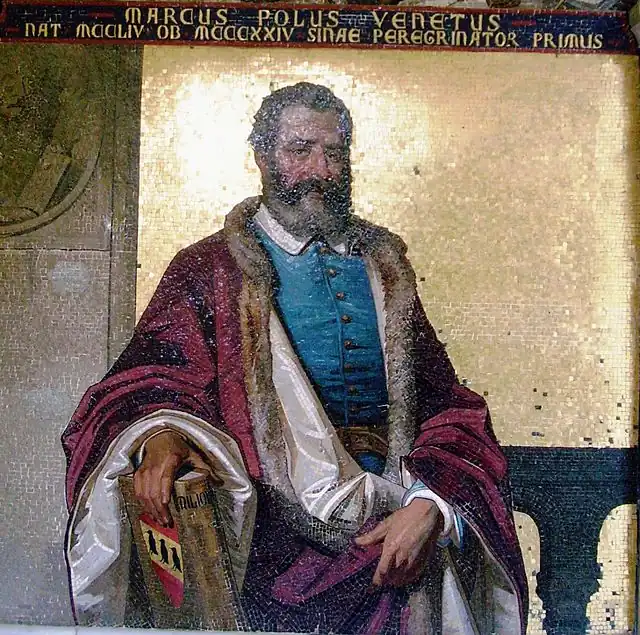
Marco Polo owes his fame to a book which he wrote after his return. At the time, there was an intense rivalry between the great trading cities of Venice, Pisa and Genoa. The Venetian Polo and his co-author, Rusticiano of Pisa, were both prisoners of war in Genoa when they met and wrote the book.
The original title translates as A Description of the World, but it is usually referred to as The Travels of Marco Polo. This was the first account of a journey to the East to be widespread in Europe, and was the best reference on Asia from its publication around 1300 until the Portuguese navigator Vasco da Gama reached the East by the Cape Route almost 200 years later. Polo's tales of the riches of the East were part of the reason for the Portuguese voyages, and also spurred on Columbus.
The book was the first in Europe to mention a number of things including oil from Iran, and coal, paper money and window glass from China. Some claim that Polo introduced noodles to Italy, but this is hotly disputed.
This itinerary is based on a version of the book downloaded from Project Gutenberg. They describe it as "the unabridged third edition (1903) of Henry Yule's annotated translation, as revised by Henri Cordier; together with Cordier's later volume of notes and addenda (1920)." All quotes are from that version.
There is considerable scholarly controversy about the book. It was written by two Italians, but the original was probably in medieval French, the trade language of the day. The oldest known copies are from a few decades later, several conflicting versions in French, Italian and Latin. A later Italian version contains additional material, apparently based on Polo family papers. Polo actually saw some of the things he speaks of, but for others he repeats tales from other travelers. Which are which? How much did Rusticiano, the writer of romances, embellish the story? Some critics say Marco never got east of Kashgar and only heard tales of central China — he never mentions chopsticks, tea, bound feet, or the Great Wall. Others cite Mongol records indicating someone named Polo was indeed there.
Fortunately, various scholars have figured out most of this. Here, we simply follow Yule and Cordier, and discuss the route as their translation gives it, ignoring the controversies.
The book generally uses Persian names for places. What about the Mongol names? Or Chinese? What was lost in various translations? In various wars? Is the city still there? Has it been renamed? We give Polo's term and the modern name. For example, Polo's Kinsay (which Yule and Cordier call Hang-Chau-Fu) is Hangzhou.
Background
The brothers Nicolo and Maffeo Polo were Venetian traders. One brother had a wife back home, but they worked mainly out of Acre (a crusader city that is now called Akko in what is now Northern Israel) and Constantinople (modern Istanbul), which Venice ruled at the time. From 1260 to 1269, the brothers made a trip to the Far East. On their second trip, starting in 1271, they brought Nicolo's teenage son Marco.
The family had strong ties to the Adriatic island of Korčula near Dubrovnik, then a Venetian possession. It seems likely Marco was born there, though he grew up mainly in Venice. Korčula is trying to develop tourism and there are some Polo-related museums and monuments there. Of course, there are also some in Venice.
Some quotes from Yule and Cordier's commentary, about the political and economic situation when the Polos set out are as follows:
- Christendom had recovered from the alarm into which it had been thrown some 18 years before when the Tartar cataclysm had threatened to engulph it. The frail Latin throne in Constantinople was still standing, but tottering to its fall. The successors of the Crusaders still held the Coast of Syria from Antioch to Jaffa. The jealousies of the commercial republics of Italy were daily waxing greater. Alexandria was still... the great emporium of Indian wares, but the facilities afforded by the Mongol conquerors who now held the whole tract from the Persian Gulf to the shores of the Caspian and of the Black Sea, or nearly so, were beginning to give a great advantage to the caravan routes.
- In Asia and Eastern Europe scarcely a dog might bark without Mongol leave, from the borders of Poland... to... the Yellow Sea. The vast empire which Chinghiz had conquered .. was splitting up into several great monarchies... and wars on a vast scale were already brewing.
"Chinghiz" is an alternate spelling for Genghis Khan. The "wars on a vast scale" involved his descendants vying for power as the empire split up.
The first trip east
The brothers set out from Constantinople (modern Istanbul) in 1260, and sailed across the Black Sea to Soldaia (now Sudak) in the Crimea. Soldaia was a largely Greek city at that time and routinely traded with various Mediterranean ports.
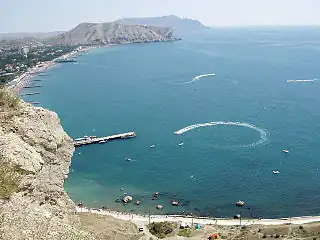
- It had belonged to the Greek Empire, and had a considerable Greek population. After the Frank conquest of 1204 it apparently fell to Trebizond.
You can still take a boat from Istanbul to Trebizond (now called Trabzon) in eastern Turkey; one variant of the Istanbul to New Delhi over land itinerary uses this. There might also be boats to Sudak or nearby Sevastopol.
- It was taken by the Mongols in 1223... about the middle of the century, the Venetians established a factory there... Ibn Batuta... counts Sudak as one of the four great ports of the World.
Ibn Batuta was a Tunisian who set out east in 1325 and also wrote of his travels.
- The Genoese got Soldaia in 1365 and built strong defences, still to be seen.
In this period the great trading cities of Genoa, Venice and Pisa dominated the Mediterranean world. One of the tourist sights of modern Sudak is the ruins of a Genoese fortress.
Where the brothers were more daring than most other traders was continuing beyond Soldaia, deeper into Mongol territory. They went into the Caucasus to Sarai, capital of this part of the Mongol Empire, near modern Astrakhan, Russia. Then a war between Mongol factions broke out, preventing a return west.
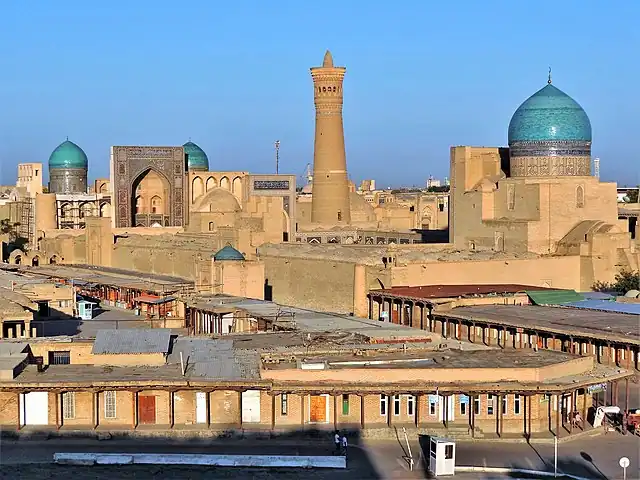
Unable to go west, the brothers headed east to the great city of Bokhara, which like everything else in Central Asia had been conquered by the Mongols a generation earlier.
- After they had passed the desert, they arrived at a very great and noble city called BOCARA... The city is the best in all Persia.
- ... up till the conquest by Chinghiz, Bokhara, Samarkand, Balkh, etc., were considered to belong to Persia.
"Chinghiz" is Genghis Khan.
Today, Bokhara and Samarkand are cities in Uzbekistan, and Balkh is a town with some interesting ruins in Northern Afghanistan. The Persian Empire was once much larger than modern Iran, including much of Central Asia. The brothers lived in Bokhara for three years and became fluent in Persian.
In Bokhara, they learned that the Great Khan, Kublai — grandson of Genghis and, at least in theory, overlord of all Mongols — had never met a European and had expressed curiosity about and goodwill toward them. So they went on, traveling via Samarkand, Kashgar, Turfan and Hami (the northern branch of the Silk Road) to his summer capital in Xanadu somewhat northwest of modern Beijing.
The Khan received them warmly and sent them back west with letters for the Pope, expressions of friendship and requests for missionaries and scholars.
- The Brothers arrived at Acre in... 1269, and found that no Pope existed, for Clement IV was dead... and no new election had taken place. So they went home to Venice to see how things stood there after their absence of so many years.
- The wife of Nicolo was no longer among the living, but he found his son Marco a fine lad of fifteen.
On the second trip, the brothers brought young Marco along.
The second trip
The brothers went back to Acre, this time with young Marco, and then up to Jerusalem to get some oil from the holy sepulchre which the Khan had requested. They then set off east again without a papal reply to the Khan's letters.
Word reached them that a Pope had finally been elected, and that it was their friend Theobald, papal legate in Acre. They returned to Acre, got replies to the letters, and headed off for Kublai's court again in late 1271. They had letters from the Pope and two friars instead of the 100 scholars the Khan had requested, but the friars soon turned back. It is interesting to speculate on how history might have been different if the Pope had sent the requested 100 scholars, or even if the friars had stuck it out. The Khan also invited scholars and missionaries from other places — Tibetan Buddhists and Persian Muslims — and those had a great effect on China.
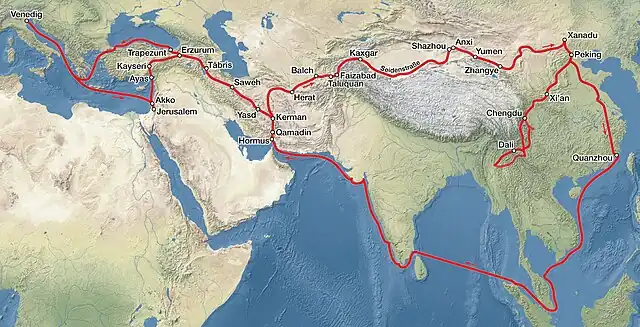
They went east overland, traveling by caravan and heading for Hormuz on the Persian Gulf. Today the city is gone but the phrase the Straits of Hormuz still turn up in newscasts; they are the narrows at the outlet of the Gulf. The nearest modern city is Bandar Abbas, capital of Iran's Hormuzgan province.
Their route was indirect, setting out from the Mediterranean toward Kayseri and Erzurum in what is now eastern Turkey, through parts of Armenia and Georgia to Mosul in what is now Iraq, then into Persia (now known as Iran) via Tabriz, Yazd and Kerman to Hormuz. The book talks of Damascus and Baghdad, but it is doubtful they actually visited those cities.
The original plan was to take a ship east from Hormuz, but after reaching Hormuz they decided to swing north instead. They would later come to Hormuz by sea, taking the Maritime Silk Road on the return journey.
The three men went back to Kerman and on to Persia's eastern province of Khorasan. This put them on the main Silk Road route. The branch they took involved going northeast to Balkh, capital of Bactria. From there, they took the difficult route along the Wakhan Corridor to reach what is now the Karakoram Highway up in the northern areas of what is now Pakistan.
From there, their route is not entirely clear; most likely they went via Srinagar and Leh, then took the pass north from there. In any case they reached Khotan in what is now Xinjiang. The brothers had taken the northern branch of the Silk Road around the Taklamakan Desert on the previous trip. Khotan is in the middle of the southern branch, so naturally they continued east on that branch.
Travels in China
They reached the Khan's capitals and were warmly welcomed. The winter capital was then called Khánbálik or Canbulac, meaning the Khan's camp; it later grew into Beijing. The summer capital was northwest of Beijing across the Great Wall, near a town Polo called Kaimenfu. The palace itself was Shangtu or Xanadu. Much later, Polo's book would inspire Coleridge:
"In Xanadu did Kubla Khan
A stately pleasure-dome decree;
Where Alph, the sacred river ran,
Through caverns measureless to man
Down to a sunless sea."
Yule and Cordier's summary of China's situation at the time is as follows:
- For about three centuries the Northern provinces of China had been... subject to foreign dynasties; first to the _Khitan_... whose rule subsisted for 200 years, and originated the name... CATHAY, by which for nearly 1000 years China has been known. The Khitan... had been displaced in 1123 by the Chúrchés... of the same blood as the modern Manchus. Already in the lifetime of Chinghiz himself the northern Provinces of China Proper, including their capital. Peking, had been wrenched from them, and the conquest of the dynasty was completed by Chinghiz's successor Okkodai in 1234.
"Chingiz" is Genghis Khan. China is still "Kithai" in modern Russian. Another romanisation of "Chúrchés" is "Jurchen".
- Southern China still remained in the hands of the native dynasty of the Sung, who had their capital at the great city now well known as Hang-chau fu. Their dominion was still substantially untouched, but its subjugation was a task to which Kúblái before many years turned his attention, and which became the most prominent event of his reign.
The "Sung" are also called the "Southern Song". "Hang-chau fu" is Hangzhou.
- Kúblái received the Venetians with great cordiality, and took kindly to young Mark, ...[and] began to employ him in the public service.
By the time the Polos reached China the second time, the Khan had subjugated Southern China, which the book calls "Manzi." However, he needed officials to help rule it and did not yet fully trust the newly-conquered Chinese. Along with many others, Marco became an official of the empire, a job that soon had him traveling over large parts of China.
- His first mission apparently was that which carried him through the provinces of Shan-si, Shen-si, and Sze-ch'wan, and the wild country on the East of Tibet, to the remote province of Yun-nan.
The provinces mentioned are modern Shanxi, Shaanxi, Sichuan and Yunnan. Marco visited many cities along the way; here are his comments on some.
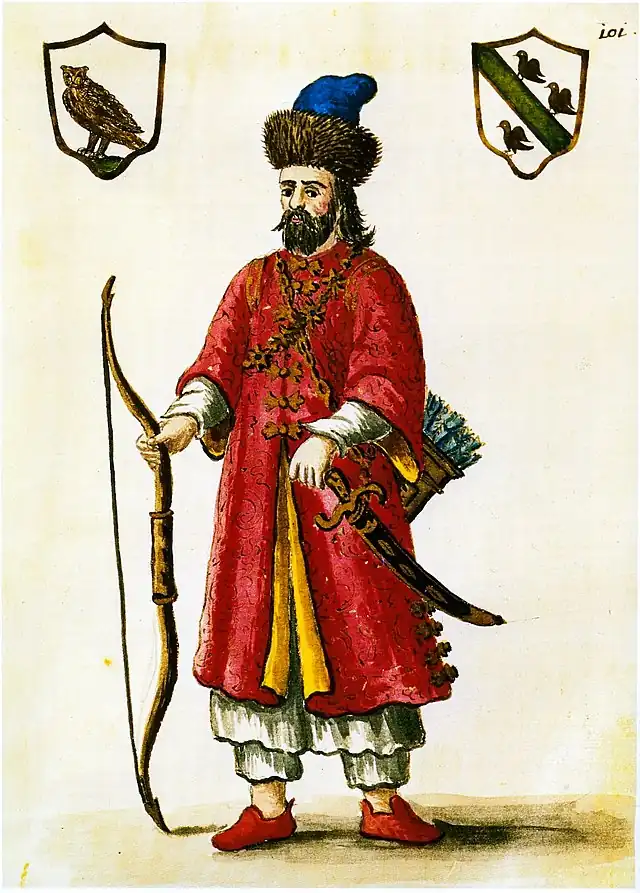
Taiyuan
- Taianfu is a place of great trade and great industry, for here they manufacture a large quantity of the most necessary equipments for the army of the Emperor.
Taiyuan is the capital of Shanxi. The area has iron and coal and makes steel.
Xi'an
- A very great and fine city it is, and the capital of the kingdom of Kenjanfu, which in old times was a noble, rich, and powerful realm... It is a city of great trade and industry. They have great abundance of silk, from which they weave cloths of silk and gold of divers kinds, and they also manufacture all sorts of equipments for an army.
- This is a fine palace and a great, as I will tell you. It stands in a great plain abounding in lakes and streams and springs of water. Round about it is a massive and lofty wall, five miles in compass, well built, and all garnished with battlements. And within this wall is the king's palace, so great and fine that no one could imagine a finer. There are in it many great and splendid halls, and many chambers, all painted and embellished with work in beaten gold.
Chengdu
- This city was in former days a rich and noble one, and the Kings who reigned there were very great and wealthy. It is a good twenty miles in compass.
- Through the midst of this great city runs a large river, in which they catch a great quantity of fish. It is a good half mile wide, and very deep withal ... The multitude of vessels that navigate this river is so vast, that no one who should read or hear the tale would believe it. The quantities of merchandize also which merchants carry up and down this river are past all belief. In fact, it is so big, that it seems to be a Sea rather than a River!"
Tibet
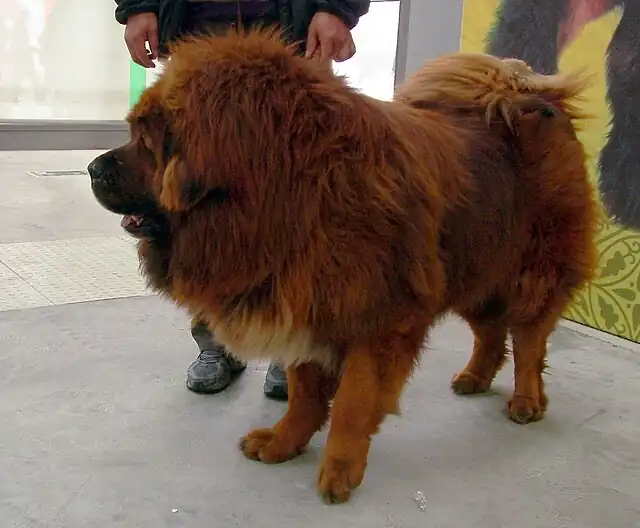
- This province, called Tebet, is of very great extent. The people, as I have told you, have a language of their own... Moreover, they are very great thieves.
- Coral is in great demand in this country and fetches a high price, for they delight to hang it round the necks of their women and of their idols. They have also in this country plenty of fine woollens and other stuffs.
- Among this people, too, you find the best enchanters and astrologers that exist in all that quarter of the world; they perform such extraordinary marvels and sorceries by diabolic art, that it astounds one to see or even hear of them. So I will relate none of them in this book of ours; people would be amazed if they heard them, but it would serve no good purpose.
- They have mastiff dogs as big as donkeys, which are capital at seizing wild beasts ... and excellent lanner falcons [and sakers], swift in flight and well-trained, which are got in the mountains of the country.
Yunnan
- The people are of sundry kinds, for there are not only Saracens and Idolaters, but also a few Nestorian Christians. They have wheat and rice in plenty. Howbeit they never eat wheaten bread, because in that country it is unwholesome. Rice they eat, and make of it sundry messes, besides a kind of drink which is very clear and good, and makes a man drunk just as wine does.
The Nestorians were the first Christians to evangelize along the Silk Road. From Yunnan, Polo circled back to Chengdu, probably via Guizhou.
Later trips
Of Marco's others trips, Yule and Cordier say:
- Mark rose rapidly in favour... but we gather few details as to his employments. At one time we know that he held for three years the government of the great city of Yang-chau... passing a year at Kan-chau in Tangut... visiting Kara Korum, the old capital of the Kaans in Mongolia... in Champa or Southern Cochin China and... on a mission to the Indian Seas, when he appears to have visited several of the southern states of India.
Yang-chau is Yangzhou in Jiangsu. The modern town of Karakorum, southeast of the current capital of Mongolia, Ulaanbaatar, has two ruined cities nearby, one the Mongol capital which Polo visited and the other the Uighur capital a few centuries earlier. Champa was a kingdom in what is now Vietnam.
The Tangut or Western Xia were a people of largely Tibetan ancestry, originally from Western Sichuan. For several hundred years before the Mongol conquest they had a Buddhist kingdom, independent but paying tribute to the Sung Emperor. It was centered in what is now Ningxia, but at its peak it was much larger than Ningxia and was quite rich. It was the first non-Chinese kingdom one entered going west on the Silk Road. There are Tangut royal tombs near Yinchuan, their capital. Much of the art in the Buddhist grottoes at Dunhuang is from the Western Xia.
Beijing
Polo called what we now know as Beijing Cambaluc, which translates as "the Khan's camp".
- You must know that the city of Cambaluc hath such a multitude of houses, and such a vast population inside the walls and outside, that it seems quite past all possibility. There is a suburb outside each of the gates... In those suburbs lodge the foreign merchants and travellers, of whom there are always great numbers... thus there are as many good houses outside of the city as inside....
- Moreover, no public woman resides inside the city, but all such abide outside in the suburbs. And 'tis wonderful what a vast number of these there are for the foreigners; it is a certain fact that there are more than 20,000 of them living by prostitution.
- To this city also are brought articles of greater cost and rarity, and in greater abundance of all kinds, than to any other city in the world. For people of every description, and from every region, bring things (including all the costly wares of India, as well as the fine and precious goods of Cathay itself with its provinces)....
- As a sample, I tell you, no day in the year passes that there do not enter the city 1000 cart-loads of silk alone....
- Round about this great city of Cambaluc there are some 200 other cities... from which traders come to sell their goods and buy others... so that the traffic of the city is passing great.
Not much of the Yuan Dynasty city of Canbulac survives in modern Beijing, though part of its wall is now a tourist attraction. Most of the city's famous monuments were built by their successors, the Ming Dynasty (1368-1644).
Kashgar
- Cascar... constituted a kingdom in former days... they have beautiful gardens and vineyards, and fine estates and grow a great deal of cotton. From this country many merchants go forth about the world on trading journeys. The natives are a wretched, niggardly set of people; they eat and drink in miserable fashion. There are in the country many Nestorian Christians.
Nestorius was the archbishop of Constantinople in the fifth century. His teaching was condemned at the Council of Ephesus in 431, but survived in the Assyrian Church which was supported by the Persian Empire as an alternative to the Byzantine Church. The Nestorians were quite active as missionaries in the East, reaching as far as Korea. There are relics throughout Central Asia and China, notably including a stele at Xi'an.
Jinan
- Chinangli is a city of Cathay. There runs through the city a great and wide river, on which a large traffic in silk goods and spices and other costly merchandize passes up and down.
- This... is a very great city, and in old times was the seat of a great kingdom; but the Great Kaan conquered it by force of arms. Nevertheless it is still the noblest city in all those provinces. There are very great merchants here, who trade on a great scale, and the abundance of silk is something marvellous. They have, moreover, most charming gardens abounding with fruit of large size.
Suzhou
- Suju is a very great and noble city. They possess silk in great quantities, from which they make gold brocade and other stuffs, and they live by their manufactures and trade.
- The city is passing great, and has a circuit of some 60 miles; it hath merchants of great wealth and an incalculable number of people. Indeed, if the men of this city and of the rest of Manzi had but the spirit of soldiers they would conquer the world; but they are no soldiers at all, only accomplished traders and most skilful craftsmen. There are also in this city many philosophers and leeches, diligent students of nature.
- And you must know that in this city there are 6,000 bridges, all of stone, and so lofty that a galley, or even two galleys at once, could pass underneath one of them.
Hangzhou
Polo devotes two chapters to this city. The title of the first one:

- DESCRIPTION OF THE GREAT CITY OF KINSAY, WHICH IS THE CAPITAL OF THE WHOLE COUNTRY OF MANZI.
"Kinsay" is Hangzhou and "Manzi" is Polo's term for the South of China, conquered by the Mongols a few years before. Hangzhou was the capital of the Sung dynasty, and remained important after that dynasty was deposed by the conquest.
- ... the city is beyond dispute the finest and the noblest in the world, so great that it hath an hundred miles of compass. And there are in it twelve thousand bridges of stone, for the most part so lofty that a great fleet could pass beneath them.
Polo may not be exaggerating much here. Yule and Cordier quote several later visitors — Persian, Arab, and Jesuit — with quite similar opinions.
Polo gives quite a detailed description:
- ... the number and wealth of the merchants, and the amount of goods that passed through their hands, was so enormous that no man could form a just estimate thereof....
- Inside the city there is a Lake which has a compass of some 30 miles and all round it are erected beautiful palaces and mansions. In the middle of the Lake are two Islands, on each of which stands a rich, beautiful and spacious edifice... when any one of the citizens desired to hold a marriage feast, or to give any other entertainment, it used to be done at one of these palaces.
West Lake, in the center of the city, is now a UNESCO World Heritage Site.
- Both men and women are fair and comely, and for the most part clothe themselves in silk, so vast is the supply of that material...
- The Kaan watches this city with especial diligence because it forms the head of all Manzi; and because he has an immense revenue from the duties levied on the transactions of trade therein. ...
- I repeat that everything appertaining to this city is on so vast a scale, and the Great Kaan's yearly revenues therefrom are so immense, that it is not easy even to put it in writing, and it seems past belief....
- Furthermore there exists in this city the palace of the king who fled ... and that is the greatest palace in the world ... inside the walls are the finest and most delectable gardens upon earth, and filled too with the finest fruits. There are numerous fountains in it also, and lakes full of fish.
Fuzhou
- Now this city of Fuju... is a seat of great trade and great manufactures.
- There flows through the middle of this city a great river... and many ships are built at the city which are launched upon this river. Enormous quantities of sugar are made there, and there is a great traffic in pearls and precious stones. For many ships of India come to these parts bringing many merchants who traffic about the Isles of the Indies.
Mawei, just outside Fuzhou, still builds ships. Many of the ships and crew for Zheng He's great voyages of the 1400s came from this area. The French destroyed the place and a large part of the Chinese navy that was moored there, in the late 19th century.
The return trip
After a few years, the Polos were ready to go home. As Yule and Cordier put it:
- Anyhow they were gathering wealth, and after years of exile they began to dread what might follow old Kúblái's death and longed to carry their gear and their own grey heads safe home to the Lagoons. The aged Emperor growled refusal to all their hints, and but for a happy chance we should have lost our mediaeval Herodotus.
At this time, the Mongols ruled most of Asia and the Great Khan had vassals in various places. One of these ruled Persia, today known as Iran.
- Arghún Khan of Persia, Kúblái's great-nephew, had in 1286 lost his favourite wife... and... took steps to fulfil her dying injunction that her place should be filled only by a lady of her own kin. Ambassadors were despatched... to seek such a bride ... the choice fell on the lady Kokáchin, a maiden of 17. The overland road from Peking to Tabriz was not only of portentous length for such a tender charge, but was imperilled by war, so the envoys desired to return by sea. Tartars in general were strangers to all navigation; and the envoys... begged the Kaan as a favour to send the three _Firinghis_ in their company. He consented with reluctance, but, having done so, fitted the party out nobly for the voyage, charging the Polos with friendly messages for the potentates of Europe, including the King of England.
On the trip, they visited several of the main ports of the Maritime Silk Road.
The great port, Zaiton
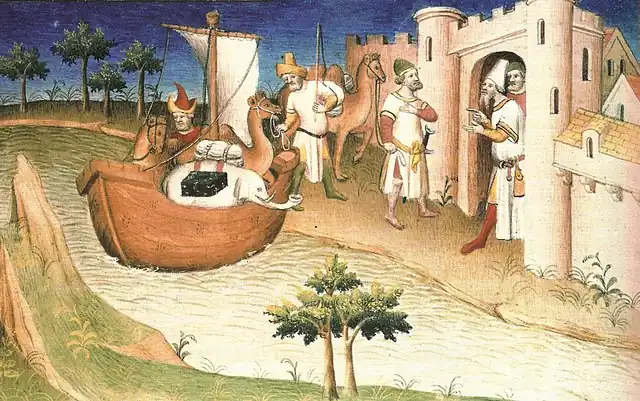
They sailed in a fleet of 14 ships with 600 passengers from Zaiton in Fujian province. Zaiton is generally thought to be modern Quanzhou, though some scholars argue in favour of Xiamen. The English word "satin" is thought to be derived from "Zaiton," the original source for its export. It was from this port that Kublai Khan's ill-fated expedition against Japan sailed.
Polo's description is long and detailed. Some highlights:
- ... frequented by all the ships of India, which bring thither spicery and all other kinds of costly wares. ... hither is imported the most astonishing quantity of goods and of precious stones and pearls... I assure you that for one shipload of pepper that goes to Alexandria or elsewhere, destined for Christendom, there come a hundred such, aye and more too, to this haven of Zayton; for it is one of the two greatest havens in the world for commerce.
- Many come hither from Upper India to have their bodies painted with the needle in the way we have elsewhere described, there being many adepts at this craft in the city.
The journey would take two years and cost many lives. The book says only 18 passengers survived, but all three Polos and the bride were among them.
Chinese ships
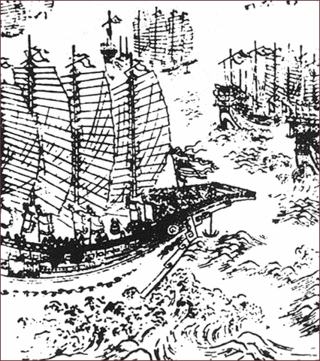
Marco describes the Chinese ships in some detail:
- They have but one deck, though each of them contains some 50 or 60 cabins... The ship hath but one rudder, but it hath four masts; and sometimes they have two additional masts... Each of their great ships requires at least 200 mariners [some of them 300].
- ... some thirteen compartments or severances in the interior, made with planking strongly framed, in case mayhap the ship should spring a leak... the planking is so well fitted that the water cannot pass from one compartment to another.
These are much larger than European vessels of the day and the system of watertight compartments was far ahead of contemporary European methods. The Chinese routinely sailed to India, Arabia and even East Africa several hundred years before the great European voyages of discovery, and Arabs and Persians sailed to China; see Maritime Silk Road.
The journey west
Polo did not himself visit Japan but he digresses to give a fairly detailed account of "Chipangu" and of Kublai Khan's unsuccessful invasion attempt.
They stopped in Champa, a kingdom in Indochina paying tribute to the Khan. It is not entirely clear where this was, probably somewhere in modern Vietnam. Polo describes Java, but it is not clear if he actually visited it. They did stop in a city Polo calls Malaiur. This was in the area of modern Singapore and Malacca, but it does not seem to have been either of those.
After that, they spent several months in Sumatra, probably waiting out the monsoon season. Polo calls this "Lesser Java" and gives much detail of various kingdoms, commerce, religion and culture. They also visited the Andaman and Nicobar islands and Sri Lanka en route to India.
In India, he visited several places on the East Coast including the tomb of Saint Thomas near Madras. On the West Coast, the first stop was naturally Calicut on the Malabar coast, now Kerala, then along the coast to Thane near Bombay and to Khambhat in Gujarat. He describes Sindh but does not seem to have stopped there. He also describes several inland provinces of South India.
He describes the Indian Ocean island of Socotra reasonably well, then goes on to talk of Madagascar and Zanzibar which he gets quite wrong. Presumably he was repeating travelers' tales for these. He also describes Abyssinia, now Somalia and Eritrea, but it is not clear if he went there. He also discusses Aden, a city in Yemen which was then the capital of an empire that included Somalia and Eritrea, but it is not clear if he visited there.
- This Aden is the port to which many of the ships of India come with their cargoes; and from this haven the merchants carry the goods a distance of seven days further in small vessels. At the end of those seven days they land the goods and load them on camels, and so carry them a land journey of 30 days. This brings them to the river of ALEXANDRIA, and by it they descend to the latter city. It is by this way through Aden that the Saracens of Alexandria receive all their stores of pepper and other spicery; and there is no other route equally good and convenient by which these goods could reach that place.
Eventually they reached Hormuz and continued overland to Tabriz to deliver the bride. The planned bridegroom having died in the meanwhile, she married his son.
The Polos then returned home, sailing from Trebizond (Trabzon) on the Black Sea to Constantinople (Istanbul) and on to Venice which they reached in 1295.